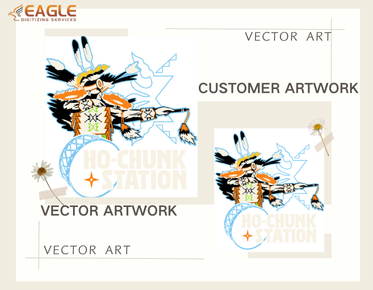Understanding Embroidery Digitizing and Its Importance
What is Digitizing?
Embroidery Digitizing refers to the process of converting analog data—such as objects, images, sounds, or documents—into a digital format. This process involves representing data through a set of samples, commonly known as digital representation. In simpler terms, digitizing transforms physical or analog data into digital data, making it accessible for computers and other digital devices to read and manipulate. Digital images, sounds, and documents are key examples of this transformation.
How Does Digitizing Work?
The core idea behind digitizing is to take analog input, like a photograph, audio, or drawing, and convert it into a format that computers can read, store, and process. This is achieved by breaking down the analog information into a series of samples or bits, which the computer can then reassemble into a digital representation. Whether it’s for preserving data, enhancing accessibility, or streamlining processes, digitization has become a cornerstone of modern technology.
Role of a Digitizer in the Digitization Process
What is a Digitizer?
A digitizer is an electronic tool or device that plays a critical role in the digitization process. It converts physical, hand-drawn images or designs into digital data that can be interpreted by computers. These designs can then be edited, stored, and used for a variety of applications. Essentially, a digitizer acts as a bridge between physical artwork and digital representation, allowing manual sketches to enter the digital world.
How Does a Digitizer Work?
The digitization process using a digitizer is fairly straightforward. The design or image is created on a specialized drawing board using a stylus, which interacts with the board’s sensitive surface. The digitizer captures the coordinates where the stylus touches the surface and converts this graphical information into digital form. This digital data can then be manipulated, stored, and transmitted electronically for further use, simplifying the process of transferring artwork to a computer.
Embroidery Digitizing: Merging Tradition with Technology
What is Embroidery Digitizing?
Embroidery digitizing is the process of converting a physical or analog embroidery design into a digital format, which can then be interpreted by an embroidery machine. This digital format allows the machine to automatically stitch the design onto fabric, creating a highly accurate and detailed embroidered product. The key to this process is the embroidery digitizer, which plays a pivotal role in converting the design into a machine-readable format.
How Does Embroidery Digitizing Work?
Embroidery digitizing works by first transferring the hand-drawn or digital design into a computer, where specialized software converts it into a format that can be read by embroidery machines. The machine is then programmed to follow this digital blueprint, stitching the design onto the fabric. This method eliminates the manual labor traditionally associated with embroidery and offers faster, more precise results.
The Role of an Embroidery Digitizer
What is an Embroidery Digitizer?
An embroidery digitizer is the specialized tool that bridges the gap between a hand-drawn design and the machine that embroiders it onto fabric. This device ensures that the embroidery machine accurately follows the design, translating artistic concepts into real-world embroidered products. Without an embroidery digitizer, the process would remain manual and time-consuming.
Why is an Embroidery Digitizer Important?
The embroidery digitizer makes the entire embroidery process more efficient. Designs, patterns, and sequences are digitally transferred to the computer, which then communicates with the embroidery machine. The digitizer not only simplifies the process but also increases the precision of the design’s reproduction. From corporate logos to intricate fabric designs, an embroidery digitizer ensures that the finished product is both cost-effective and high-quality.
Benefits of Embroidery Digitizing
Simplifies a Complex Process
The traditional method of hand-stitching designs onto fabric is both labor-intensive and time-consuming. Embroidery digitizing simplifies this process by automating the task, reducing the complexities associated with manual embroidery. By using digital tools, artists and designers can focus on creativity, leaving the repetitive task of stitching to the machines.
Time-Efficiency and Precision
One of the primary advantages of embroidery digitizing is the significant reduction in time. What once took hours or even days to embroider by hand can now be done in a fraction of the time using an embroidery machine. Moreover, the precision of machine embroidery ensures that designs are reproduced exactly as intended, down to the smallest detail.
Cost-Effectiveness
Embroidery digitizing also offers cost benefits. Machine-embroidered fabrics or logos are generally cheaper than those that are embroidered by hand. This is because machines can produce large volumes of embroidered products more quickly and with less manual labor, driving down costs without sacrificing quality.
Why You Should Consider Embroidery Digitizing for Your Business
Streamlining Your Business Process
If you are involved in the embroidery business, adopting embroidery digitizing can significantly streamline your operations. By automating the design-to-fabric process, you can increase productivity and reduce labor costs, all while maintaining high-quality results.
Leveraging the Power of Technology
Embroidery digitizing allows businesses to leverage the power of modern technology to improve their service offerings. With the right equipment, businesses can offer custom, high-quality embroidered products at a competitive price. It is an efficient and scalable way to grow an embroidery business.
Staying Competitive in the Market
As embroidery digitizing becomes more popular, businesses that do not adopt this technology may struggle to stay competitive. Offering quick turnaround times, precise designs, and cost-effective solutions will give you an edge in the marketplace. The digitization process allows for greater flexibility and creativity, making it an invaluable tool for embroidery businesses looking to expand their offerings.
Conclusion: The Future of Embroidery Digitizing
Embroidery digitizing is revolutionizing the way we think about embroidery. By merging traditional design concepts with cutting-edge technology, embroidery digitizing offers a more efficient, cost-effective, and precise way to produce high-quality embroidered products. For businesses in the embroidery industry, adopting this technology is not just an option but a necessity for staying competitive in the ever-evolving market.
FAQs About Embroidery Digitizing
1. What equipment is needed for embroidery digitizing?
To start embroidery digitizing, you’ll need a computer, digitizing software, and an embroidery machine. A digitizer device may also be required to convert physical designs into digital data.
2. Can any design be digitized for embroidery?
Yes, almost any design can be digitized for embroidery, but some complex designs may require additional adjustments to ensure they are suitable for machine stitching.
3. How long does it take to digitize a design?
The time required to digitize a design depends on its complexity, but with the right tools, it can be done relatively quickly, often within hours.
4. What is the cost of embroidery digitizing software?
Embroidery digitizing software ranges from affordable to premium, depending on its features and capabilities. Prices can vary widely based on the software’s complexity.
5. How can embroidery digitizing benefit small businesses?
For small businesses, embroidery digitizing offers a way to increase production speed, lower costs, and provide more detailed and custom designs, helping them compete with larger companies.



